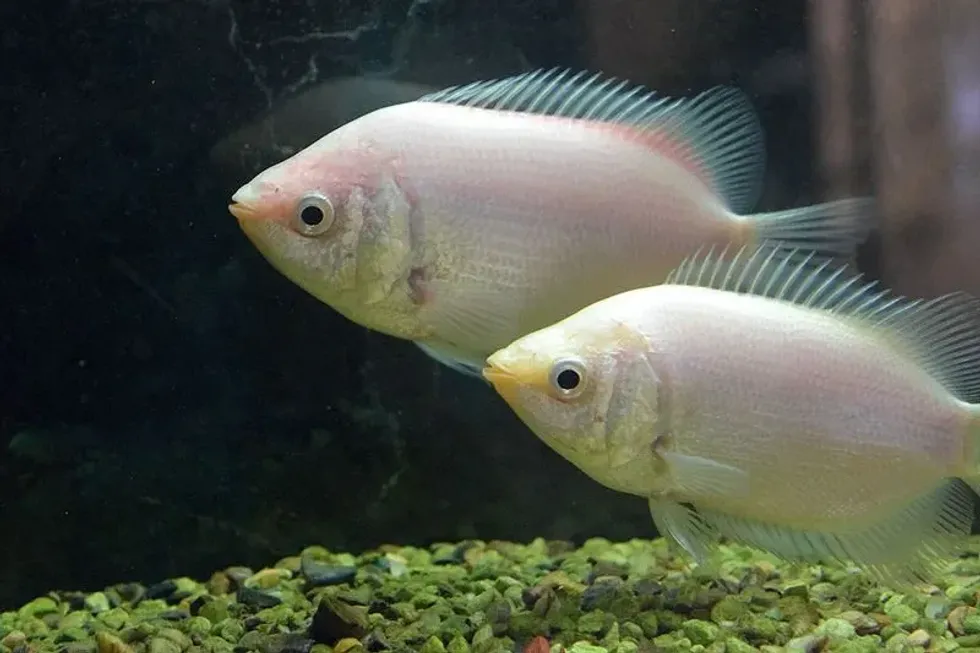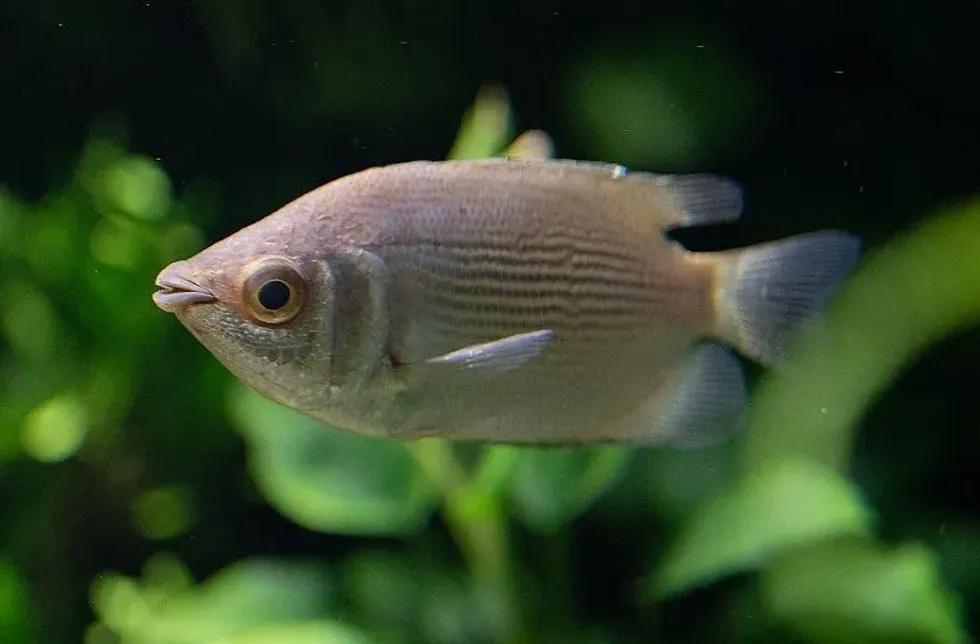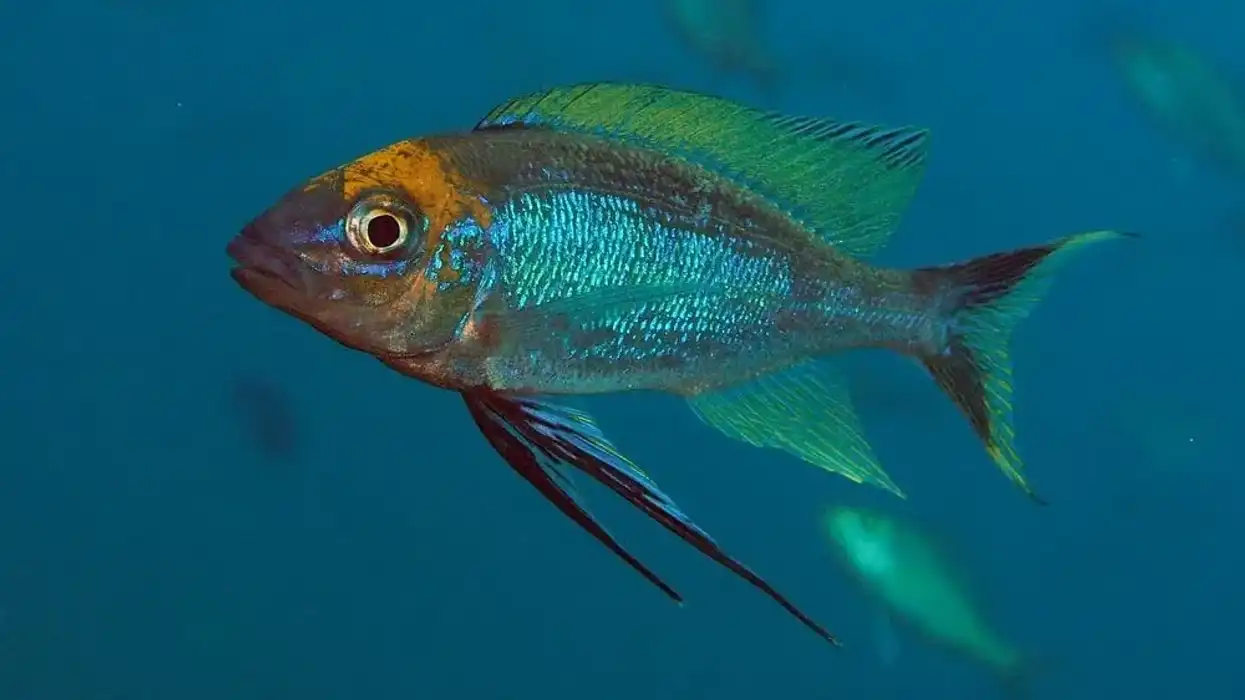Fun Kissing Gourami Facts For Kids
Content
- What type of animal is a kissing gourami?
- What class of animal does a kissing gourami belong to?
- How many kissing gourami are there in the world?
- Where does a kissing gourami live?
- What is a kissing gourami's habitat?
- Who do kissing gourami live with?
- How long does a kissing gourami live?
- How do they reproduce?
- What is their conservation status?
- What do kissing gourami look like?
- How cute are they?
- How do they communicate?
- How big is a kissing gourami?
- How fast can a kissing gourami swim?
- How much does a kissing gourami weigh?
- What are the male and female names of the species?
- What would you call a baby kissing gourami?
- What do they eat?
- Are they aggressive?
- Would they make a good pet?
- Did you know...
- Kissing fish: why do they kiss?
- Differences between a kissing gourami and other gourami
Are you interested in learning about fishes that are kept in aquariums? If yes, then you must know about kissing gourami (Helostoma temminckii).
They are also known as kisser fish, because of their protruding lips. The flat fish originated in Thailand and Indonesia, and they can also be found in Sumatra, Borneo, and Java.
In the wild, this fish is usually green in color, earning it the name green kisser. They are a freshwater fish that likes to live in stagnant waters like ponds and marshes or in streams, but they are currently mostly found in aquariums all over the world.
These fishes also like to live in habitats that contain lots of plants.
Kissing gourami care, along with their light pink color, makes the fish a favorite among kids. Even though the fish is known to feed on algae in their wild habitat, they like to feed on live or frozen foods in aquariums.
Kissing gourami can be semi-aggressive, or even aggressive, to other fish species so it is crucial to find suitable tank mates. The popularity of these fishes makes them abundant in the population.
Want to learn more about kissing gourami? Keep reading to find interesting things about the green kisser and its other variants. Also, check out these articles on needle fish and mekong giant catfish to learn more about other fish species.
Kissing Gourami Interesting Facts
What type of animal is a kissing gourami?
Kissing gourami (Helostoma temminckii) is a type of tropical fish.
What class of animal does a kissing gourami belong to?
Kissing gouramis (Helostoma temminckii) belong to the class actinopterygii, and to the genus helostoma.
How many kissing gourami are there in the world?
As this freshwater fish is often artificially bred as an aquarium fish, the exact population of the species is not known.
Where does a kissing gourami live?
Originally, kissing gouramis are a tropical freshwater fish that hail from Indonesia, Thailand, Borneo, Java, and Sumatra. Currently, kissing gourami are artificially produced throughout the world as a popular aquarium pet. This means that the fishes are present almost everywhere.
What is a kissing gourami's habitat?
The natural habitat of kissing gourami includes tropical backwaters that are well-vegetated and have slow-flowing water. These fishes are also found in ponds and lakes.
Kissing gourami usually reside at midwater level, which is best suited for feeding on plant materials. The average depth for kissing gourami is around 6.56 ft (2 m).
In their natural habitat, the fish prefer a temperature range of 71.6-86°F (22-30˚C). It is also recommended to maintain this temperature range when kissing gourami fish are kept in an aquarium. If you are planning to get one for your home, kissing gouramis usually require a really large tank.
The fishes prefer a pH level of 6.5-7.5. The waters hardness should also be maintained around 5-20 dGH.
Who do kissing gourami live with?
Kissing gourami aren't hugely social fishes and keeping many of them in the same tank may lead to aggressive battles. However, you can get away with this by keeping a male and a female together.
Kissing fish also tend to pick fights with fishes that look similar to them.
Nevertheless, some of the tank mates that can live with kissing gouramis include yoyo loaches, swordtails, tiger barbs, Chinese algae eaters, angelfish, congo tetra, rosy barb, and pictus catfish. In their natural habitat, kissing gourami fishes are quite important for maintaining the ecology as they directly interact with algae.
How long does a kissing gourami live?
In the wild, the average lifespan of kissing gourami fishes is between five to seven years. This might be similar in the case of an aquarium, but there are instances where kissing fishes have managed to live even 20 years.
When owning a kissing gourami, it is important to remember that they are a hardy fish and they may need care for a long time.
How do they reproduce?
Kissing gourami fishes reproduce by spawning once a year. Male and female kissing gourami swim together and the fertilization takes place externally.
Female fishes can produce thousands of eggs in a single spawning. Monsoon season is usually when kissing gourami choose to breed. Kissing gourami may also move to flooded forests or shallow rivers before the spawning starts to take place.
Females are the ones that initiates the mating, and the males often follow suit. Females get upside down to spawn the eggs, and the males release their sperm to fertilize the tiny eggs.
Kissing gouramis have smaller eggs compared to other freshwater fishes and the eggs have a covering of oil droplets which helps them to float. The eggs rise and become attached to the available vegetation. It takes between one to two days for the eggs to hatch, and the parent kissing gouramis have no role in bringing up the fry.
The young fishes start free swimming just after hatching. It takes about three years for kissing gouramis to reach sexual maturity.
What is their conservation status?
Kissing gourami fishes are currently listed as Least Concern as per the International Union for Conservation of Nature (IUCN) Red List.
Kissing Gourami Fun Facts
What do kissing gourami look like?
Kissing gouramis are known for having a flattened body with rounded caudal, dorsal, and anal fins. The dorsal fins of the fishes are longer than the anal fin.
The fishes also have longer and rounded pectoral fins. The lateral line of the fish is divided into two parts, and they have about 43 to 48 scales running through it. Putting aside their large body, the most interesting part of this fish is their mouth.
The protruded mouth of the kissing fish is lined with fine teeth. Artificial breeding has also led to the creation of the balloon kissing gourami, which has a smaller body with larger protruding lips.
The fish has ctenoid on their body and cycloid scales on their head. No particular sexual dimorphism is seen in the species, so it is often hard to tell the males and females apart.
One kissing gourami interesting fact is that wild kissing fish have gray or green-colored skin, while ones bred for the aquarium have light pink colored skin. The fins of the pink, or balloon pink-colored fish, are almost transparent.
However, there are some theories that believe the pink morph originated in Java. Both green kissing gourami and gray kissing gourami variants have a dark band running across their fins.
The interesting look of kissing gourami is because of their intramandibular joint which is present between their jaw joint and other joints. The lips of a kisser fish help them to receive important nutrients while bottom-feeding.

How cute are they?
Cuteness is the best quotient of kissing gourami fishes and their cuteness even makes the fishes extremely famous as an aquarium pet. Apart from the usual pink kissing gourami, balloon pink kissing gouramis look even cuter because of their shortened body and big head.
How do they communicate?
Kisser fish have a suprabranchial air breathing chamber, which helps these fishes to have the ability to hear even the tiniest of sounds. When it comes to vocalization, kisser fishes also make unique sounds with their pharyngeal teeth.
How big is a kissing gourami?
In their wild habitat, the average size of a kissing gourami is 12 in (30 cm) but the fish can easily grow to a size of 15.5 in (40 cm). The fishes are definitely much bigger than honey gourami.
These only grow to a size of 3 in (7 cm). However, kissing gouramis are half the size of giant gouramis who have an average size of 28 in (71 cm).
How fast can a kissing gourami swim?
Not much is known about the swimming speed of kissing gourami fishes. However, as residents of slow streams, these fish do not seem to be rapid swimmers.
How much does a kissing gourami weigh?
The average weight of a kissing gourami fish isn't known, but the species are not thought to be very heavy.
What are the male and female names of the species?
There are no distinct names for male and female kissing gouramis.
What would you call a baby kissing gourami?
Baby kissing gourami fishes are called fry.
What do they eat?
One of the most interesting aspects of kissing gourami fish is their diet. The fishes are omnivorous in nature, but most of their diet consists of plants. The kissing gesture of the fishes helps them to take nutrients from plants. Common kissing gourami food includes phytoplankton, zooplankton, benthic algae and aquatic plants.
The fishes also have aquatic insects as a part of their diet. Kissing fishes are also known for bottom-feeding. As the fishes have gill rakers, the filtering helps the fish in extracting nutrients from the water.
In an aquarium where the fishes cannot have access to most of their usual food sources, they will eat live foods like bloodworms. Prepared fish food that has been specially made for gouramis can also work great.
As a freshwater fish, kissing gouramis don't like clouded water so make sure to give an exact amount of food to avoid murky water. The fishes are also known to eat blanched vegetables like spinach, lettuce, or zucchini.
If you cannot find live food, try giving your gourami frozen fish food to add a much-needed protein source to their food list. If possible, feed the fishes with some algae from time to time.
Are they aggressive?
Yes, kissing gourami are known to be semi-aggressive in nature. They are quite territorial in nature and can often pick a fight with their tank mates.
The lovable kissing feature of the fish is often used to drive away other fishes that might be added to the aquarium. Hence, you need to be quite careful about adding tank mates that look like other gouramis as this can lead to aggressive behavior from kissing fishes.
Would they make a good pet?
Yes, kissing gouramis make an amazing aquarium fish and they are quite popular all around the world. The fish is mainly distributed in Asian countries where people love to keep kissing fish.
Also, there is a misconception that this fish species needs to be kept in a pair. You can easily keep a single kissing gourami, but it should have a very large tank size.
Kissing gourami care isn't that hard, but you would need to maintain the proper temperature range to keep this tropical fish happy. You should also be careful about choosing the tank mates for your pink kissing gourami.
Loaches, barbs, and large tetras make great tank mates for kissing gourami. If you catch any fighting between the species or damage to any tail fin, it is better to separate the fishes.
As a pet owner, you might be interested in kissing gourami fish mating. People often find it daunting, as breeding this species requires a big tank size.
Both the fishes should have enough space to come up for air at the surface as well as enough space to swim. The perfect water temperature should be maintained to give them an opportunity to thrive.
Make sure to install a good filter to keep the water clean and fresh. You should also place plants on the surface of the water to catch the eggs that are laid by the fish.
With a proper environment for breeding and a large tank, kissing gourami females will soon start to spawn, and they may produce 1000 or more eggs. The eggs will slowly float to the surface of the water and attach themselves to the plants.
You need to quickly collect the egg-filled plants from the surface and place them in a different tank. The eggs will hatch in around 24 to 48 hours to reveal free-swimming kissing gourami babies.
The newly hatched fry will usually stay near plants to feed on infusoria. Brine shrimp also act as a good food source for the babies.
Did you know...
Gourami have a special type of organ, known as the labyrinth organ, that allows them to directly get oxygen from the air rather than from the water like other fishes.
Java ferns and Java moss work well in the aquarium habitat of kissing gouramis.
As a freshwater fish, kissing gourami may get fungal infections, so you may need to closely monitor their scales for any potential disease. If any anomaly is seen, remove their other tank mates to stop the disease from spreading.
Kissing fish: why do they kiss?
The fishes don't actually kiss. Gourami kissing provides the fish with an ability to suck on their food. The fish also uses their kissing mouths as a way to be semi-aggressive towards other fishes. As a territorial fish, kissing gourami can be a little daunting to other fishes or even fellow kissing gouramis.
Differences between a kissing gourami and other gourami
The main difference between kissing gourami and other gourami species is their protruded mouth that look like lips. The fish can also be smaller than some other gourami species like the giant gourami.
Here at Kidadl, we have carefully created lots of interesting family-friendly animal facts for everyone to discover! Learn more about some other fish including firefish, or honey gourami.
You can even occupy yourself at home by drawing one of our kissing gourami coloring pages.
We Want Your Photos!
More for You
See All
Bachelor of Arts specializing in Journalism and Mass Communication, Postgraduate Diploma in Sports Management

Moumita DuttaBachelor of Arts specializing in Journalism and Mass Communication, Postgraduate Diploma in Sports Management
A content writer and editor with a passion for sports, Moumita has honed her skills in producing compelling match reports and stories about sporting heroes. She holds a degree in Journalism and Mass Communication from the Indian Institute of Social Welfare and Business Management, Calcutta University, alongside a postgraduate diploma in Sports Management.
Disclaimer
1) Kidadl is independent and to make our service free to you the reader we are supported by advertising. We hope you love our recommendations for products and services! What we suggest is selected independently by the Kidadl team. If you purchase using the Buy Now button we may earn a small commission. This does not influence our choices. Prices are correct and items are available at the time the article was published but we cannot guarantee that on the time of reading. Please note that Kidadl is a participant in the Amazon Services LLC Associates Program, an affiliate advertising program designed to provide a means for sites to earn advertising fees by advertising and linking to Amazon. We also link to other websites, but are not responsible for their content.
2) At Kidadl, we strive to recommend the very best activities and events. We will always aim to give you accurate information at the date of publication - however, information does change, so it’s important you do your own research, double-check and make the decision that is right for your family. We recognise that not all activities and ideas are appropriate for all children and families or in all circumstances. Our recommended activities are based on age but these are a guide. We recommend that these ideas are used as inspiration, that ideas are undertaken with appropriate adult supervision, and that each adult uses their own discretion and knowledge of their children to consider the safety and suitability. Kidadl cannot accept liability for the execution of these ideas, and parental supervision is advised at all times, as safety is paramount. Anyone using the information provided by Kidadl does so at their own risk and we can not accept liability if things go wrong.
3) Because we are an educational resource, we have quotes and facts about a range of historical and modern figures. We do not endorse the actions of or rhetoric of all the people included in these collections, but we think they are important for growing minds to learn about under the guidance of parents or guardians.







